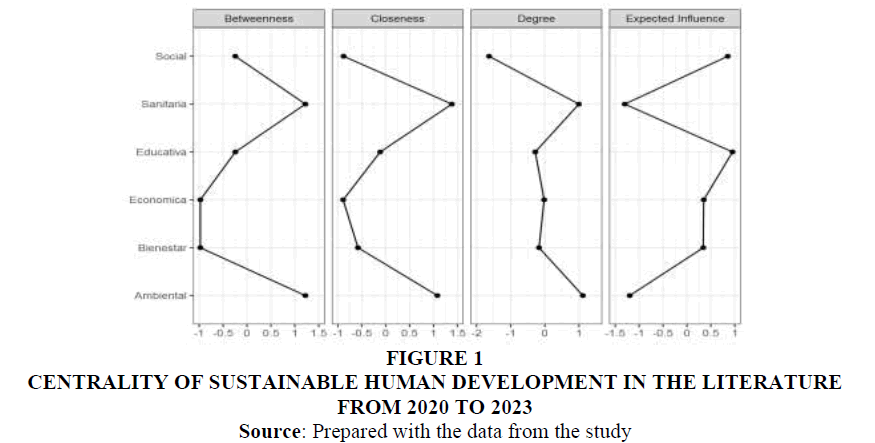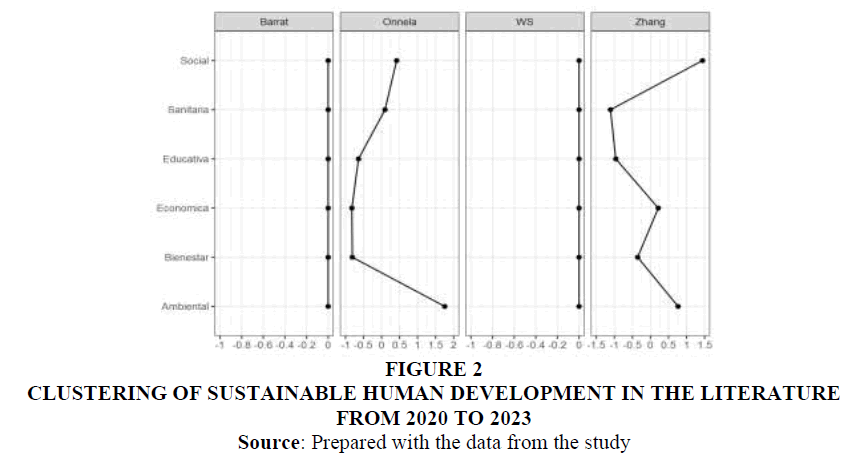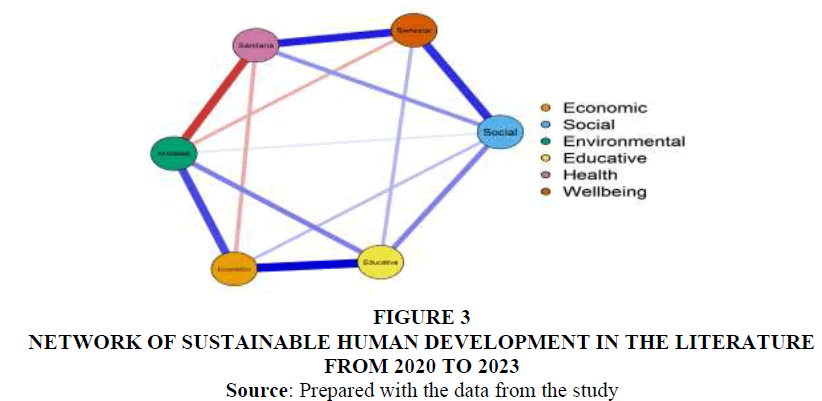Research Article: 2023 Vol: 27 Issue: 4
Human Development Network in Literature from 2020 to 2023
José Marcos Bustos Aguayo, National Autonomous University of Mexico
Cruz García Lirios, Autonomous University of Mexico City
Francisco Rubén Sandoval Vázquez, Universidad Autónoma del Estado de Morelos
Javier Carreón Guillen, National Autonomous University of Mexico
Margarita Juárez Najera, Metropolitan Autonomous University
Citation Information: Aguayo, J.M.B., Lirios, C.G., Vázquez, F.R.S., Guillen, J.C., & Najera, M.J. (2023). Human development network in literature from 2020 to 2023. Journal of Organizational Culture Communications and Conflict, 27(4), 1-7.
Abstract
The literature from 2020 to 2023 suggests that human and sustainable developments are concomitant. The objective of this work was to establish the relationship between human and sustainable development. A cross-sectional, exploratory and correlational study was carried out with a sample of 100 students selected for their professional profile. The results show the prevalence of the environmental and social dimension as nodes of centrality and grouping. In this sense, the hypothesis that relates human development to environmental development is not rejected and a significant difference between the theoretical networks of relationships with respect to the observations of this work is accepted. In addition, the delimitation of the study to the learning of human and sustainable development in its environmental and social dimensions is recommended.
Keywords
Agenda, Human Development, Sustainable Development, Human Development Index, Sustainable Development Goals.
Introduction
The Sustainable Development Goals (SDGs), also known as the Sustainable Development Goals, are a set of 17 interconnected and ambitious goals established by the United Nations in September 2015 as part of the 2030 Agenda for Sustainable Development (Yunus et al., 2021). These goals are designed to address the most pressing global challenges and promote equitable, sustainable and inclusive development for all people and the planet. The SDGs are based on three fundamental pillars: economic, social and environmental. Below are the 17 Sustainable Development Goals:
The Sustainable Development Goals (SDG) and Human Development are closely related, since both seek to improve people's quality of life and promote equitable and sustainable development (Finatto et al., 2021). The SDGs are based on the premise that human development and sustainable development are interdependent. In other words, full human development cannot be achieved if the environment in which they live is not cared for and if an equitable distribution of resources and opportunities is not guaranteed.
Therefore, the SDGs seek to promote sustainable human development, which not only improves people's present well-being, but also protects and conserves natural resources and opportunities for future generations (Gulseven et al., 2020). These goals emphasize the importance of equality, inclusion and sustainability in all dimensions of human development, addressing not only present needs but also future needs.
Human Development refers to the process by which people improve their quality of life and develop their potential in different aspects, both physical, emotional, social and intellectual (Joshi et al., 2021). This concept focuses on the search for a full and satisfying life for all individuals.
Human Development seeks to improve people's lives, promoting respect for human rights, equity and access to opportunities so that everyone can reach their full potential and lead a dignified and satisfying life (Mukherjee et al., 2020). The study of human development is an interdisciplinary discipline that encompasses various areas of research and theoretical approaches.
In the Psychology of Human Development, there is no single universal "scale" that encompasses all aspects of human development (Srivastava et al., 2020). Instead, various theories and models are used to study different dimensions of development throughout life. These theories and models provide conceptual frameworks to understand how individuals change and develop in aspects such as cognitive, emotional, social, and moral development.
Jean Piaget's Theory of Cognitive Development: This theory describes how children develop their ability to think and reason as they grow (Ferrannini et al., 2021). It proposes different stages of cognitive development, from the sensorimotor stage in childhood to the stage of formal operations in adolescence.
Human Development has been a subject widely studied and promoted by international organizations such as the United Nations Development Program (UNDP), which annually publishes the Human Development Index (HDI), a measure that combines indicators of health, education and income to classify countries according to their level of development (Singh, 2022).
The measurement of human development is a complex process that seeks to assess and compare the progress of different countries or regions in terms of human well-being and quality of life (Khetrapal & Bhatia, 2020). One of the best known and most used measures in this context is the Human Development Index (HDI), created by the United Nations Development Program (UNDP).
The HDI calculation process involves normalizing each of the indicators so that they have values between 0 and 1 and then calculating the arithmetic average of the three normalized indicators (Contipelli & Picciau, 2020). Thus, the HDI can vary between 0 (lowest human development) and 1 (highest human development).
In addition to the HDI, there are other measures and indices that are also used to assess human development and its dimensions, such as the Gender Inequality Index (IDG), the Multidimensional Poverty Index (MPI) and the Gender Development Index (IDG).
Gender Inequality Index (IDG): It is a measure that evaluates gender disparities in access to education, political participation and economic participation (Deka, 2021). It measures gender inequality in relation to the HDI.
Multidimensional Poverty Index (MPI): It is a measure that assesses poverty from a multidimensional perspective, taking into accounts not only income but also other deficiencies, such as education, health, and access to basic services (Thoradeniya & Jayasinghe, 2021).
Gender Development Index (GDI): It is a measure that evaluates the differences between men and women in terms of human development (Abul-Fadl & Sarhan, 2020). It combines HDI and GDI indicators to show how gender differences affect human development.
Social Development Index (IDS): It is a measure that evaluates human development from a broader perspective, considering factors such as the quality of housing, social security, community participation, among others (Özsoy & Gürler, 2022).
Development Index of Happiness (IDF): Although it does not directly measure human development, the Happiness Index is a measure that assesses subjective well-being and life satisfaction in different countries (Odey et al., 2021). It can provide complementary information on people's quality of life.
However, the human development indices exclude the SDGs as prospective axes (Fleetwood, 2020). In this sense, the relationship between the SDGs and human development transcends the present and reaches its value in the future as preventive axes of the barriers that impede sustainable human development.
Therefore, the objective of this study was to establish the axes and themes of the prospective agenda around the SDGs and human development.
Are there significant differences between the SDG agenda and the human development agenda?
H1: The anti-pandemic policies led to the link between the SDGs and human development through a common agenda to face the health crisis. In this sense, the differences are not significant between the SDG agenda and the human development agenda. H2: The anti-pandemic agendas stemming from the SDGs and human development involve the establishment of issues related to risk prevention, although they are distinguished by their priority focus on preserving the environment for future generations, or for current ones. Thus, significant differences are expected between the two agendas. H3: The distinctions between the SDG and human development agendas imply asymmetries in the reviews of the state of the art. Thus, the differences are significant, since the SDG agenda is more circumstantial than the human development agenda.
Materials and Methods
Design: A correlational exploratory cross-sectional study was carried out.
Sample: 100 students were selected (M=23.3 DE=24.3 age and M = 9'987.00 DE=298.00 monthly income) considering their affiliation to a public university in central Mexico, as well as their registration in the system of professional practices and social service of the university in alliance with public health institutions.
Instrument: The Sustainable Human Development Inventory was used, which includes the economic, social, environmental, educational, health and well-being dimensions. Benford's test suggests that the data is distributed according to the minimum percentage essential to be able to carry out more sophisticated analyses,
Procedure: Students were contacted through their institutional email. The participants were informed about the objective and those responsible for the project. The confidentiality and anonymity of the responses were guaranteed in writing, as well as non-remuneration for their participation. A focus group of 10 people was carried out in order to standardize the concepts of the study. Delphi evaluation groups were organized for the comparison of qualifications in three rounds. The instrument was applied via email.
Analysis: Data were processed in Excel and JASP version 14. Centrality, clustering, and structuring coefficients were estimated to test the null hypothesis of significant differences between the sustainable human development agenda and student assessments.
Results
The intermediation, proximity, gradation and influence coefficients suggest that the environmental dimension is the node that filters the other nodes in a learning logic of sustainable human development embodied in the literature from 2020 to 2023. In other words, sustainable human development is mediated by the environmental dimension Figure 1.
The clustering coefficients indicate the cumulative differences between the mediation nodes. The environmental and social node agglomerate the differences between the nodes. That is, the relationships between the nodes suggest a configuration of their differences. The environmental and social nodes intersperse this function Figure 2.
Reading a network is done from left to right and from top to bottom. The structure is the result of three layers of nodes. The first input layer reflects the start of learning sustainable human development. The second layer of processing suggests the prevailing centrality and clustering in the environmental node. The third output layer reflects the results of the learning process. In this way, the structure found begins with the environmental node, where the relationships between the other nodes are processed and the final result of the sustainable human development process is of a social order. In other words, the literature consulted has been evaluated as a social process Figure 3.
The parameters of centrality, grouping and structuring suggest the non-rejection of the null hypothesis regarding the significant differences between the theoretical structure with respect to the observations made in the present work. It means then that sustainable human development is conceptualized as a learning process of economic conditions and measurements, but the sample surveyed suggests that it should be thought of as a socially oriented environmental structure.
Discussion
The contribution of this work to the state of the art consists in the establishment of a neural network model to explain the learning of the literature related to the SDGs and human development. The results indicate that the literature guides the SDG and human development agendas towards an economic dimension, but the present study suggests that it is conceptualized as a process that goes from the environmental to the social. This finding is consistent with the literature on the SDGs and human development as social learning sequences, given that the economic, environmental, or health dimensions are seen as distant from the university academic community (Bwire et al., 2022). Therefore, it is recommended to delimit the study to the social environmental dimensions in order to be able to anticipate risk exposure scenarios. If the environmental dimension prevails over the other dimensions and is also a catalyst for them, then it is possible to demonstrate that risk communication can be directed towards social indicators such as solidarity, fraternity or support.
In addition, if the environmental dimension regulates the other dimensions except the social dimension, then it supposes a communication oriented towards the relationship between humanity and nature (Sikka et al., 2021). In this sense, the conservation of nature would be indicated by concrete actions of recycling or protection of animal and plant species. Such behaviors favorable to the conservation of nature can coexist with actions that favor the dynamics of the academic community such as the transfer of knowledge. In this way, it is suggested to continue the relationship between the environmental and social dimensions as the beginning and end of a learning process of sustainable human development.
Conclusion
The objective of this work was to establish a comparison between a theoretical model of human development and the SDGs as economic learning processes with respect to the evaluations of a sample of students. The results show that sustainable human development is the result of learning about the environmental dimension such as recycling or the protection of species with respect to actions that favor connectivity such as solidarity, fraternity and support. In reference to the consulted literature, the findings converge in the environmental and social version of the SDGs and human development. In addition, a learning sequence is appreciated between nodes that represent the environmental and social dimensions.
However, the findings inherent to the sample cannot be generalized to the public university. Furthermore, the literature review was limited to an informetrics design and not bibliometrics or scientometrics. Therefore, the extension of the study towards a design that allows measuring the impact of references on the learning of an academic community dedicated to the study of the SDGs or human development is recommended.
References
Abul-Fadl, A., & Sarhan, A. (2020). Using human development indices to identify indicators to monitor the corona virus pandemic.Journal of Current Viruses and Treatment Methodologies,1(1), 48-57.
Bwire, G., Ario, A.R., Eyu, P., Ocom, F., Wamala, J.F., Kusi, K.A., & Talisuna, A.O. (2022). The COVID-19 pandemic in the African continent.bmc Medicine,20(1), 1-23.
Indexed at, Google Scholar, Cross Ref
Contipelli, E., & Picciau, S. (2020). Post-COVID-19: Rebuilding our paradigms through sustainable development goals and the sufficiency economy philosophy. Indra Stra Global.
Deka, B. (2021). Emerging issues of human development in a Covid-19 world. Multicultural Education, 7 (9).
Ferrannini, A., Barbieri, E., Biggeri, M., & Di Tommaso, M.R (2021). Industrial policy for sustainable human development in the post-Covid19 era. World Development, 137, 105215.
Indexed at, Google Scholar, Cross Ref
Finatto, C.P., da Silva, C.G., de Aguiar Dutra, A.R., Borchardt Deggau, A., Cubas, A.L.V., Moecke, E.H.S., & de Andrade Guerra, J.B.S.O. (2021). Sustainability in Covid-19 times: a human development perspective.COVID-19: Environmental Sustainability and Sustainable Development Goals, 1-34.
Fleetwood, J. (2020). Social justice, food loss, and the sustainable development goals in the era of COVID-19. Sustainability, 12 (12), 5027.
Indexed at, Google Scholar, Cross Ref
Gulseven, O., Al Harmoodi, F., Al Falasi, M., & ALshomali, I. (2020). How the COVID-19 pandemic will affect the UN sustainable development goals?.
Joshi, T., Mainali, RP, Marasini, S., Acharya, KP, & Adhikari, S. (2021). Nepal at the edge of the sword with two edges: The COVID-19 pandemics and sustainable development goals. Journal of Agriculture and Food Research, 4, 100138.
Indexed at, Google Scholar, Cross Ref
Khetrapal, S., & Bhatia, R. (2020). Impact of COVID-19 pandemic on health system & Sustainable Development Goal 3. The Indian journal of medical research, 151 (5), 395.
Indexed at, Google Scholar, Cross Ref
Mukherjee, A., Babu, SS, & Ghosh, S. (2020). Thinking about water and air to attain Sustainable Development Goals during times of COVID-19 Pandemic. Journal of Earth System Science, 129, 1-8.
Indexed at, Google Scholar, Cross Ref
Odey, G.O, Alawad, A.G.A, Atieno, O.S, Carew-Bayoh, E.O, Fatuma, E., Ogunkola, I.O, & Lucero-Prisno III, DE (2021). COVID-19 pandemic: impacts on the achievements of sustainable development goals in Africa. Pan African Medical Journal, 38 (1).
Özsoy, Ö., & Gürler, M. (2022). The negative effects of covid-19 on the sustainable development goals, economic growth, foreign trade, and social life. In Public Health and Economic Resiliency in the Post-COVID-19 Era.
Sikka, G., Yenneti, K., & Singh, RB (2021). IGU-YECG special issue: Geospatially and sustainable development goals. Geography, Environment, Sustainability, 14 (1), 6-8.
Indexed at, Google Scholar, Cross Ref
Singh, UK (2022). Impact of COVID-19 on Sustainable Development Goals. In Human Development in Bihar, India: Experiences of Millennium Development Goals. Singapore: Springer Nature Singapore, 131-147.
Srivastava, A., Sharma, R.K, & Suresh, A. (2020). Impact of Covid-19 on sustainable development goals. International Journal of Advanced Science and Technology , 29 (9), 4968-4972.
Thoradeniya, T., & Jayasinghe, S. (2021). COVID-19 and future pandemics: a global systems approach and relevance to SDGs. Globalization and health, 17 (1), 59.
Indexed at, Google Scholar, Cross Ref
Yunus, M., Biggeri, M., & Testi, E. (2021). Social economy and social business supporting policies for sustainable human development in a post-covid-19 world. Sustainability, 13 (21), 12155.
Indexed at, Google Scholar, Cross Ref
Received: 02-Jul-2023, Manuscript No. JOCCC-23-13863; Editor assigned: 04-Jul-2023, Pre QC No. JOCCC-23-13863(PQ); Reviewed: 18-Jul-2023, QC No. JOCCC-23-13863; Revised: 25-Jul-2023, Manuscript No. JOCCC-23-13863(R); Published: 31-Jul-2023


